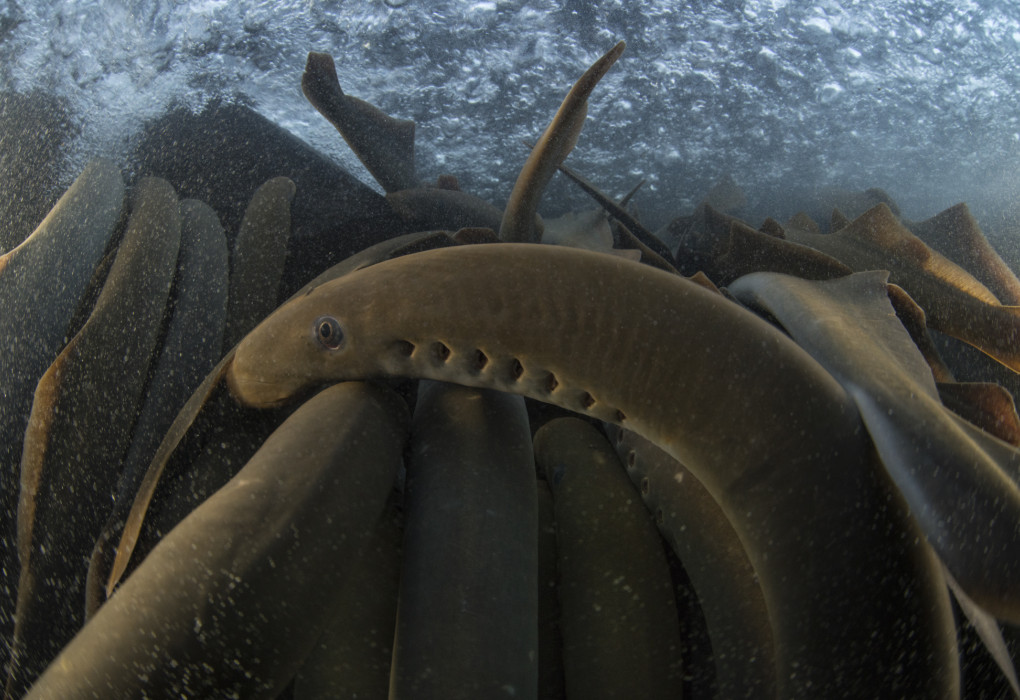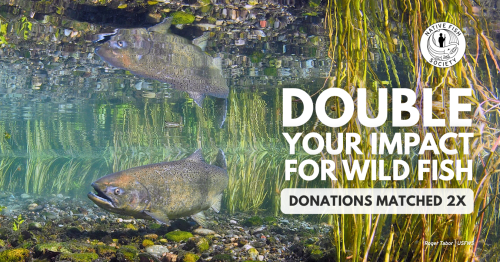Pacific Lamprey
Words by Keith Parker, Fisheries Biologist Yurok Tribe
The link between aquatic and terrestrial ecosystems facilitated by anadromous fish species has been described as significant, as well as the connection between oceanic and freshwater ecosystems. These links are exemplified by the life history of an understudied fish, which has been around for approximately 400 million years and survived several mass extinction events, the anadromous Pacific lamprey. Not long ago, Pacific lamprey had separate taxonomies for the adult and the larval life stages due to a metamorphosis the larval form undergoes, which transforms Pacific lamprey appearance.
Larval lamprey are filter feeders with no teeth or eyes. Sometime between ages 2 to 7, during the summer months, larval lamprey gradually develop eyes, kidneys, and that infamous oral disc with teeth. Now considered juveniles, they emerge from the river substrate and begin swimming downstream to the estuary between the late fall and spring. Eventually, they enter the ocean where Pacific lamprey feed on a variety of hosts, including fishes and whales, by latching on with their sucker-like disc and drilling into them using a bony tongue. They are a polite guest, surviving off the bodily fluids of their host and only occasionally killing it. Lamprey saliva has been found to contain proteins with anticoagulative, antioxidative, antibacterial, and analgesic properties to suppress the adverse responses generated from hosts.
After 1 to 3 years in the marine waters, Pacific lamprey navigate to their upriver spawning grounds by following a pheromone trail secreted by larval stage lamprey digestive tracts. Unlike salmon, Pacific lamprey do not necessarily return to their natal streams. This ‘Suitable River Strategy’ is thought to work based on the concept that if the habitat is healthy enough to support larval stage lamprey, then it is suitable habitat for spawning. Also, since adult Pacific lamprey are at the mercy of the travel plans of their host, it may not be possible for the adult to swim hundreds of miles back to their natal river once they enter into the reproductive stage.
Most Pacific lamprey die in freshwater after a return spawn migration, where nitrogen, carbon, and other substances produced from carcass decomposition are absorbed by the benthic sections of streams and adjacent riparian areas. This process contributes essential marine-derived micro-nutrients and organic matter to the food web of low nutrient streams and terrestrial areas. Nutrient input results in increased plant growth, which increases herbivore food supply and macroinvertebrate and terrestrial insect habitat, resulting in a larger insect population. The increased insect biomass results in improved stream productivity by providing higher food availability for juvenile salmon and other fish. Lamprey biomass is also a key in-stream food source for salmon fry, sturgeon, and filter-feeding ammocoetes as well as bear, mink, fishers, river otter, blue heron, eagles, osprey, kingfishers, and many other creatures.
The Klamath River Basin (KRB) of remote Northern California and Southern Oregon supports the highest diversity of lamprey species of any single watershed in the World, with Pacific lamprey suggested to have been the KRB’s most abundant fish species historically. So many Pacific lamprey in fact that Native Tribes of the KRB recount traditional stories of Pacific lamprey returning for spawning migration in such mass that indigenous people would avoid the river for days due to a brown film and strong odor which formed on the water surface post-spawn and death. However, since the mid- 1800s, KRB resources have been exploited through overfishing, commercial logging, gold mining, water diversions, and dams without fish passage. Dams, in particular, have had a catastrophic impact as multiple dams have cut off hundreds of miles of former spawning and rearing habitat for Pacific lamprey.
Currently, Pacific lamprey harvest in the KRB has reduced by several orders of magnitude since the 1960s due to massive declines in abundance, impacting KRB Tribes with adverse health, social, and spiritual effects. Language, religion, ceremony, traditional food sources, and other cultural practices are intertwined and evolve synchronously in a society, not independently; remove any one societal feature and the other features are all negatively impacted. For example, correlations between the reduction or loss of Omega 3 fatty acid-rich fish consumption and near epidemic increases in the cases of obesity, diabetes, mental health disease, and other health issues have been observed in Native American communities. “At the core of Tribal sovereignty is food sovereignty. Food is a foundational part of Tribal cultures which feed much more than our physical bodies – traditional foods feed our Spirits. This is because foods represent our living link with our land.” -Valerie Segrest, Muckleshoot Tribe.
The cultural and subsistence importance of Pacific lamprey, or “Eels” as Tribal people call them, cannot be overstated. Eels provide Tribal people with high lipid food during the cold winter months when the salmon are not running and sustain marine mammal populations, which Yurok Tribal members also harvested and consumed historically. Eels have significantly higher lipid content—the highest Omega 3 fatty acid content of any seafood at 1,300 mg/100 gm mass, providing higher caloric value per unit body weight (6 kcal/g wet mass) than salmon (1.3 to 2.9 kcal/g wet mass). For the remote Tribal river and fish people of the KRB, the rivers have acted as their grocery stores, supplying fish packed with marine-derived nutrients since time immemorial.
While Pacific lamprey are a Tribal trust fish species protected under treaty and other rights, they do not have a recreational or commercial value. This is the reason there is little funding to perform research and why it is one of the least studied fish in the Pacific Northwest. However, I was able to secure funding from the National Science Foundation and the Robert and Patricia Switzer Foundation to investigate the association of genetic variation with ecotypic differentiation in Pacific lamprey as they initiated their anadromous migration. The objective of this study was to combine next-generation genetic sequencing with traditional ecological knowledge to evaluate imperiled Pacific lamprey and apply the findings to conservation in the context of resolving Native American traditional food security issues.
We intercepted 219 individuals over 12 months in the Klamath River utilizing Native American traditional knowledge of harvest technique (handmade eel hook), run-timing, and locations. Each individual was genotyped at 308 neutral and adaptive single nucleotide polymorphism gene locations at the CRITFC lab in Hagerman, ID through a collaborative agreement. Morphological traits were also recorded, including egg mass as an indicator of female sexual maturity.
The onset for freshwater migration for an ocean- maturing ecotype (mature eggs) identified was predominantly the winter; Whereas a river- maturing ecotype (immature eggs) entered during all seasons and a genetic basis of the ecotype diversity was discovered. Genotype-phenotype association mapping identified sixteen gene locations significantly associated to egg mass forming two groups of linked genes and ten other genes significantly associated to total length. Substantial egg mass variation is observed in female Steelhead (winter-run versus summer-run) and salmonids (spring- run versus fall-run chinook); both species exhibiting substantial temporal differences in egg mass segregated by seasonal run times. Remarkably, these life history variations were not observed in Pacific lamprey with the river- and ocean-maturing ecotypes, analogous to spring- and fall-run salmon respectively, having concurrent migration with collection of both ecotypes with distinguishing large and small egg masses occurring at the same time.
An inheritance model was developed which best supported the ocean- and river-maturing ecotypes, accurately predicting ecotype in 83% of the samples. The adaptive genetic variation revealed is useful for conservation planning as it indicates that the river-maturing ecotype carries standing genetic variation capable of producing both ecotypes, while the ocean-maturing ecotype is almost exclusively homozygous. Therefore, when assessing stream restoration projects, the river-maturing ecotypes could perhaps be prioritized as they contain the genetic diversity capable of producing both ecotypes (i.e., heterozygosity), whereas the ocean-maturing ecotypes do not.
In recognition of the importance of Pacific lamprey as a native fish to Pacific Northwest fishing tribes, we adopted the names ke’ween (lamprey “eel”) and tewol (ocean) for the river-maturing and ocean-maturing ecotypes respectively, using terms from the Yurok language.
Special thanks to Andrew Kinziger, PhD for his edits.

